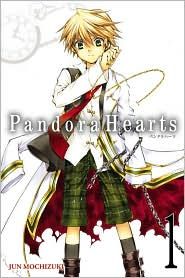Jun Mochizuki takes fairy tale symbols and logic and puts them through some kind of psychedelic wash in Pandora Hearts. The results are fairly confusing, if surprisingly compelling.
Pandora Hearts isn't a re-telling of Alice in Wonderland so much as it explodes the premise from the inside out as "Wonderland" is re-imagined as a black, terrible abyss while the "real world" isn't the comforting refuge for sanity that it should be. The story opens on a young noble, Oz Vessalius, (what a name, right?) as he is about to be inducted into adulthood through a coming of age ceremony. Instead, his very being is deemed a "sin" by sinister and powerful men in black robes and he's thrown into the "abyss," or rather an alternative universe prison, which essentially functions as a kind of madhouse of eternal night.
Oz's "adventures" in the abyss aren't half as charming as the original Alice's. Creepy sentient dolls, vicious black bunnies and skeletons are after him, although he is saved from them when he meets a rather manipulative girl who just happens to be named Alice. Oz and Alice team up to "break out" of prison, but there isn't really a coherent logic that explains the connection between the "real" world (which is a fictional world that bears no relation to ours) and the prison world Oz and Alice escape from. Oz's world -- no matter which one he finds himself in -- is filled with nightmares, dreams, strange flights of the soul and odd slices of both recovered and repressed memories. In other words, it is if the entire manga has taken on the ethos of Wonderland and unapologetically refuses to walk in a straight, or even a wavy but discernible, line.
Upon their return to the "real" world, Oz and Alice are taken in a group called "Pandora Hearts" and a mission is manufactured for both -- Alice to recover her memories, Oz to figure out why is very existence is a "sin." This gives the manga an excuse for serialization even if I'm not sure the story will ever develop a coherent narrative logic. While the story cheerfully zigs and zags, the art acts as an excellent unifying force and often makes up for a story that is a little too exuberant for its own good. Mochizuki evokes the Victorian ostentatiousness of the original Alice in Wonderland with some goth embellishments, allowing for both the dark and light aspects of the tale to shine through.
Review copy provided by Yen Press.


